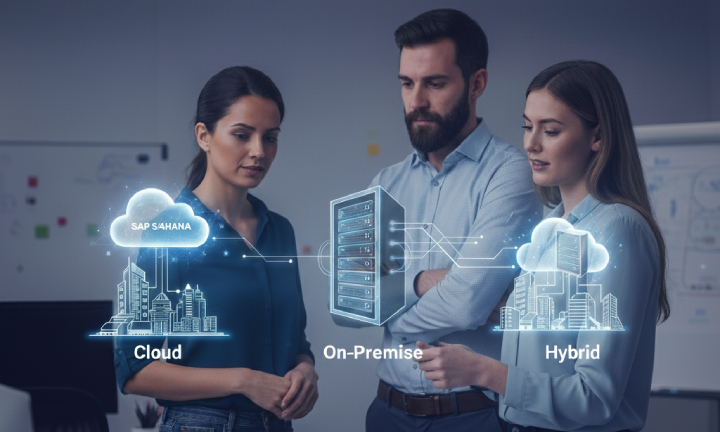For long-standing SAP businesses, it means moving critical systems and applications into new environments. Crafting a strategy for migrating SAP that sets upon everything that the cloud has to offer while maintaining all that is freeway for your business, can sometimes feel a Herculean task to achieve. But these companies that have taken the plunge and moved to the cloud are putting themselves ahead. The cloud is driving faster innovation, higher cost savings, and better collaborations across remote and hybrid modern workplaces.
Perhaps this guide is for you if you know that the time is now for building your SAP cloud migration strategy, but aren’t sure where to start. Ahead, we will explain why your company should move its SAP systems into the cloud sooner rather than later and the advantages it will gain from doing so. We will also include steps of implementation and ways to get past common migration difficulties.
What is SAP Cloud Migration?
SAP cloud migration means migrating the existing company’s on-premises SAP applications, databases, and systems from the on-premises infrastructure to a cloud environment.
This process can involve the migration of the entire SAP environment or a part of it. Cloud migration could also be performed at different scales depending on the business goal. For example, companies can:
- Move existing SAP applications without major changes.
- Upgrade existing SAP ECC-like system to SAP S/4HANA.
- Change the application to take advantage of cloud capabilities.
- Some parts move to the cloud with others remaining on-premise.
One of the biggest and most important activities involved in this migration is moving huge chunks of data with configurations from the existing SAP landscape to a cloud environment.
Why is SAP Cloud Migration So Important Right Now?
Rapidly evolving technology, rampant with changing customer expectations and global hyperconnectivity, is contributing to a fast business environment. An enormous pressure is exerted on organizations in every industry to be agile and innovative.
Traditional on-premise setups for SAP with a big and advanced system just do not provide such capabilities. To give themselves a fighting chance, companies have to move their SAP systems to the cloud.
The last couple of years have also witnessed cloud migration gathering steam with several companies going out in front and starting. The public cloud is home to over half of workloads for enterprises, along with SMBS, and Gartner predicts that by 2025, 95% of all new digital workloads will be born in cloud-native environments.
SAP Cloud Migration: What Are the Options?
SAP’s next-generation enterprise resource planning suite, SAP S/4HANA, can either be placed in the cloud or on-premise, or in-between. The solution offers flexibility to adopt and scale the systems as needed.
SAP Business Technology Platform (BTP) is a cloud-native, cloud-agnostic, comprehensive suite of tools, services, and technologies integrated and designed to be a central entity, business-centric, open-data, development, and integration platform for the entire SAP ecosystem. It provides services in the area of database and data management, integration, analytics, and application development.
Cloud-Native Platforms
- SAP BTP-Integration, data, and app development platform
- SAP Integration Suite-Integration platform (Part of SAP BTP)
- SAP SuccessFactors-Human Capital Management (HCM) Solution.
- SAP Ariba-Procurement and Supply Chain Collaboration Platform.
- SAP Concur-Expense, Travel, and Invoice Management.
- SAP Data Warehouse Cloud-Data Management and Analytics.
In addition, organizations can leverage SAP Analytics Cloud for improving business performance, enabling advanced analytics and real-time insights to drive smarter decision-making.
Partially Cloud-Native / Hybrid
SAP S/4HANA Cloud – The Cloud Edition is built for cloud-native concepts, whereas the Private Edition and On-Premises Edition are more traditional.
Why Focus on SAP S/4HANA and SAP BTP?
This article concentrates on SAP S/4HANA and SAP BTP systems, owing to the critical position they hold within the cloud transformation ecosystem of SAP. Should you create your cloud-first strategy, SAP S/4HANA and SAP BTP would be your foundational systems.
This article will be helpful if you plan to upgrade your legacy ERP system, such as SAP ECC, to S/4HANA or seek multi-cloud flexibility while building cloud-native applications through BTP.
SAP S/4HANA and SAP BTP: What are the Differences?
Being a next-generation ERP suite by SAP S/4HANA can be deployed independently in the cloud or within the on-premises environment or even in hybrid mode.
SAP Business Technology Platform (BTP) is an integrated end-to-end portfolio of services, tools, and technologies designed to serve as the core, business-centric, and open data, development, and integration platform for the entire SAP ecosystem. It has features that are related to database and data management, integration, analytics, and application development.
Accelerate Growth with SAP BTP
Explore how SAP Business Technology Platform empowers data, AI, and app development.
Planning the SAP Cloud Migration Process
A well-defined migration plan is key to successfully migrating to SAP cloud solutions. While a single plan may not suit all types of organizations, the steps mentioned below can guide the creation of a migration process and the aspects to consider.
Define Migration Objectives and Business Outcomes
The foremost step is to try and understand and get the business-side motives of migration documented, such as saving on costs, gaining agility, or innovating the processes. Setting the goals themselves establish the basis from which to get resources justified and standing upon to put forward cases for migration. Listing and quantifying business outcomes is also crucial, as they become parameters for proving success. Consider cloud migration as part of bigger digital transformation.
Involve and Align Key Stakeholders
Since the change impacts end users at large, all stakeholders must be involved. Leadership must be baited with the earliest buy-ins because their support will ease access to pertinent users and resources across departments. Companies that engage stakeholders from IT, business units, and leadership promote an aligned vision and working together toward a common goal; this fosters cooperativeness and hastens the project.
Project Planning
- SAP cloud migration and identity and access management projects impact the entire organization across IT, business, and audit. Assemble a cross-functional project team including IT, business, and audit representatives to define, manage, and execute the project. Project management is successful only if:
- Determine well-set timelines and milestones, and delegate responsibilities: Will anyone be assuming responsibilities? Resolve the question of task ownership, set deadlines, and create milestones.
- Impact Understanding: What is the transition meant to change about the teams, is it a temporary responsibility shift, or a fundamental change in day-to-day operations?
Initial Planning and Assessment
Here are the essential questions to answer to evaluate the state of your systems and tools:
- Which processes or applications that align with strategic business outcomes must be prioritized?
- Which critical data sets will migrate to the cloud? Do you need to implement data cleansing measures before migration?
- What are current infrastructure components, including applications, databases, and middleware?An adequate level of detail in the inventory is created during this phase, and the interdependencies between SAP and non-SAP systems are mapped accordingly.
- Analyze what systems are currently integrated with SAP ECC, IDM, and/or AC, to filter out what processes need to be transitioned to S/4 and whether those will also be evolved through technical migration or process re-engineering. At this stage, it’s also critical to evaluate the deployment options for SAP S/4HANA to ensure alignment between your migration strategy and infrastructure capabilities.
- Which parts of the new architecture-dependent services will need to involve SAP BTP (e.g., Integration Suite, SAP Build)?
- Identify cloud application changes that may accompany the move to S/4, including solutions like Coupa, Salesforce, or BlackLine.
- List key functionalities for each connected system, such as firefighter access, risk analysis, provisioning, and user access reviews.
- Determine any compliance requirements to baseline current practices and ascertain any adjustments to meet auditing expectations in the new setup.
Engage a Migration Partner or Managed Services Provider
Migration into the cloud is a giant step to take. It becomes even more complex for organizations still working in an on-prem environment. Partner with a managed service provider who will be with you through the whole migration process and post-migration to help reduce risks and allow a smooth transition for your business.
Simplify SAP Service Choices
Discover the 10 essential tips for choosing the right SAP Managed Services partner to ensure seamless operations, cost savings, and long-term success.
Build a Holistic Transformation Plan
A great plan will help anticipate bottlenecks and challenges ahead. This means planning for workload priorities, timelines, milestones, funding, resources, and executive-level buy-in.
Develop Implementation Roadmap
A comprehensive implementation and migration plan will be needed that outlines the organization’s end-to-end approach, including:
- Planning will be made in further detail, starting with vendor selection and culminating in the Go Live.
- The plan will consider steps, cross-functional responsibilities, and deadlines.
- Deadlines will be set with assigned deliverables applicable to both internal and external teams.
- Define a data assessment activity for assessing data quality, the data remediation plan, and data governance practices.
- The solution architecture design will include SAP applications, integration points, security controls, and future state analytics.
- Develop the deployment strategy, defining governance models, implementation phases, support strategies, and resource requirements.
Inventory of Current Infrastructure
Assess apps, databases, and on-premises infrastructure using automated cloud migration tools. A key preparatory step is to know workload-level cost estimates and performance metrics in advance.
Cost Estimation and TCO Comparison
Estimate migration expenses (licenses, cloud infrastructure, and services). Calculate total cost of ownership (TCO) and assess projected return on investment (ROI) after migration.
Risk Management and Mitigation Strategies
Cloud migration offers scaling with customization options; however, it also carries the risk of data security, applicability performance, business continuity, vendor lock-in, cost management, etc. Migration can be smoothly executed if data is encrypted, infrastructure is tested for optimization, along with providing maintainable backup and recovery plans.
SAP Cloud Migration Phases and Activities
The migration process can be broadly divided into six phases that span from assessment to deployment:
Pre-Migration Assessment
Usually, it is all about planning, for it to be successful: evaluation of your current system architecture, identification of potential challenges, and drawing up of a migration strategy. Any migration may differ from another in some way, thus, the actual tasks related to planning are likely to be similar in all scenarios.
Review Current Systems and Dependencies
Evaluate your existing and future solution requirements to determine necessary adaptations, modifications, or enhancements for a seamless migration.
Defining Requirements
Create a detailed list of business, technical, and compliance requirements:
- Classify required and nice-to-have features.
- Take the entire landscape of applications running in an anticipated cloud or hybrid environment.
- Involve cross-functional stakeholders to come together on goals and requirements of transition.
- Example questions to address:
- Is your landscape SAP-only or does it include some LoB applications?
- Is your environment on-prem, cloud, or hybrid?
- What are your requirements for identity governance (say: automated provisioning and de-provisioning)?
- How are you wanting to manage access risk governance (SOX Offence checks and user access reviews)?
- Do you require advanced security capabilities such as data masking, vulnerability management, or threat detection?
Evaluate and Select Vendors
The list of requirements helps evaluate potential vendors:
- Define criteria for scalability, good integration capabilities with other systems, and user experience.
- Rank requirements from must-have to nice-to-haves. Define minimum threshold of eligibility for vendors.
- Identify vendors fulfilling your use case and obtain an evaluation pursuant to your queries, RFPs, product demos, or customer public reviews.
- Track your timeline for procurement, including legal reviews, approvals, and vendor onboarding, to be placed in your project timeline.
Identify Feature Incompatibilities
Analyze incompatibilities and feature differences. Use the Self-Service Migration tool to detect and address potential issues.
Preparation Phase
A successful SAP cloud migration strategy is based on the preparations made. Such preparations involve budgeting of resources, setting up SAP BTP global accounts, and subaccounts to provision the SAP BTP development, test, and production environments. Planning considerably brings about a seamless transition and good performance on the cloud.
Budget Allocation
Start off with resource allocation and budget for migration to ensure smooth implementation. The more detail, the better-be sure to account for all requirements. Always try to overestimate, and you compensate by going under-budget.
Chart out the budgetary framework, including cloud infrastructure and licenses for implementation services and ongoing cost of operation. Go for a detailed review of SAP S/4HANA and SAP BTP subscription models available (maybe pay-as-you-go or long-term contracts). Factor in any hidden costs like data transfer charges, third-party integrations, training, post-migration optimization, etc. Associate budgetary decisions with operational savings and business outcomes estimates post-migration.
Set Up SAP BTP Global Accounts and Subaccounts
Register SAP BTP Global Accounts to manage cloud resources across multiple environments. Design subaccounts for the different environments (Development, Test, Production). Assign the right user permissions for each subaccount aligned with the assigned privileges. Using SAP Integration Suite, establish secured interfaces amongst the SAP BTP, SAP S/4HANA, and third-party systems.
Provision Development, Test, and Production Environments
Define landscape architecture, consisting of separate system development, testing, and production environments. Deploy cloud services and databases automatically using SAP BTP tools. Then configure security settings to encrypt data in transit and at rest, restrict data access through policies, and implement network isolation.
Development Phase
Address application and system incompatibility during development to achieve a smooth migration from on-premises SAP systems to SAP S/4HANA and cloud environments of SAP BTP. This phase shall consider the preparation of applications, custom code, and content to become fully compatible with cloud-native services.
Resolve Application Incompatibilities
Use SAP Readiness Check and ABAP Test Cockpit (ATC) to identify incompatible custom code and dependencies. Adjust ABAP custom code to align with the SAP S/4HANA architecture and cloud deployment standards. Validate API integrations with SAP Integration Suite to ensure connectivity issues are resolved between SAP S/4HANA and cloud applications. Identify and resolve compatibility issues with connected applications such as Salesforce or Coupa.
Convert Legacy Content to Cloud-Compatible Formats
Refactoring ABAP custom code is necessary to fit with the SAP S/4HANA data model and cloud-based services. Legacy database queries are to be converted into SAP S/4HANA CDS Views and Core Data Services (CDS). Similarly, legacy workflows would go through a transformation to expose them to cloud-native services on SAP BTP such as SAP Workflow Service or SAP Process Automation. Also, traditional SAP GUI interfaces should be converted into SAP Fiori apps suited for both web and mobile. The interfaces get updated to interact with the SAP BTP Integration Suite to expose them for cross-platform communication.
Migration Execution Phase
This is, then, the moment for transitioning on-premises SAP systems to the SAP S/4HANA and SAP BTP cloud environments. Data and application migrations take center stage during this phase.
Execute Migration Using SAP Tools
- Use the SAP Migration Cockpit to transfer master and transactional data from legacy systems to SAP S/4HANA with pre-configured templates.
- Use the SAP BTP Integration Suite to set up secure data integration between SAP S/4HANA and cloud-based applications or third-party systems.
- Leverage SAP Data Intelligence or SAP Cloud Integration to automate data transformation and migration tasks.
- Use ABAP Test Cockpit (ATC) to validate custom code compatibility before execution.
Monitor for Data Integrity and Compatibility
Generate reports using SAP Migration Cockpit to check for the completeness and correctness of migrated data. Use SAP Data Services or SAP Information Steward to detect data inconsistencies during migration and resolve them. Track system performance during and post-migration using SAP Solution Manager and SAP Cloud ALM at all times. Implement preconfigured workflows to handle errors so that migration issues are logged and corrected automatically.
Testing and Validation
When migration gets done, an application and data review is conducted to assert that they perform as expected and under accepted performance norms.
Functional and Performance Testing
Ensure core business processes function correctly in the new environment. Engage with business users to verify that migrated applications are supporting everyday business operations and meeting business requirements. Perform a performance assessment of the system for peak workload periods and to verify that the cloud infrastructure meets response time and scalability requirements. The SAP BTP Integration Suite validates integration points with SAP S/4HANA, SAP BTP services, and third-party applications.
Data and System Validation
Compare the data before migration and after migration to ascertain correctness of migration-because of possible loss or corruption of data. Consider the use of SAP Data Intelligence if one wants to track down any inconsistencies between source and target systems. The access controls and data encryption need to be configured properly as this often falls within strict compliance regimes such as SOX, GDPR, and SOC 2. SAP Cloud ALM and SAP Solution Manager being used during testing to monitor system performance and audit error logs are other additions.
Deployment Phase
During deployment comes the setting up of the SAP cloud environment that would enable the smooth migration. The key activities of this stage shall include cloud resource provisioning, installation of SAP applications, configuration of network connectivity, and adjustment of migration tasks against business requirements. This stage shall set the foundation for successful migration.
Production System Setup
In-line with the architecture finalized during the preceding phases, deploy SAP S/4HANA and SAP BTP services in production. Load in all the final data and reconcile everything to keep all systems current. The SAP BTP Integration Suite implements integration between SAP systems, third-party applications, and cloud services. Disaster recovery configurations should be validated, and high-availability setups established before going live.
Security Configuration
Configure SAP Cloud Identity Services for role-based access controls (RBAC) and multi-factor authentication (MFA). Make sure data is encrypted both at rest and in transit between the SAP Business Technology Platform (BTP) and the SAP S/4HANA. Limit the access to administrative accounts and monitor for any violations since 75% of cloud security failures are caused by lack of identity, access, and privilege management. Through the use of SAP Cloud Identity Access Governance, verify that security settings are implemented in a way that complies with regulatory requirements such as GDPR and SOC 2.
Go-Live and Post-Migration Monitoring
During the go-live phase, operations are transitioned to the SAP cloud with minimal disruption. A cutover plan ensures system continuity. Post-migration monitoring focuses on performance, data integrity, and system health. Automated alerts and dashboards support ongoing optimization.
Post go-live, it is critical to have a defined plan for the transition from the implementation team to the day-to-day users and administrators. This plan should include:
Cutover Process: Ensure that the cutover process is well-communicated to minimize interruptions during the transition.
Training and Adoption: Create massive training campaigns and materials so users can quickly and effectively get on board with the system.
Standard Operating Procedures: Provide an agreed-upon basis for processes that help with long-term system success.
Support Structures: Establish support channels, help desks, knowledge bases, etc., to provide continued support.
Performance and Compliance Monitoring: Monitor system performance, assess benefits, and ensure compliance on an ongoing basis.
Continuous Improvement: Feedback loops should be established for users and stakeholders in order to collect input in the form of suggestions for system improvement and enhancement.
Post-Migration Optimization
Fine-Tuning Cloud Environment for Performance
Optimizing your cloud environment becomes paramount when migrating a system from on-premise to the cloud. This involves configuring the cloud infrastructure to fully support the SAP environment so that it delivers on the requested performance, scalability, and reliability. Well-performed refinements cut down disturbances and lay a foundation for long-term operational success.
Ongoing Monitoring and Improvement
No migration can be perfect. This improves performance and user experience through reviewing and tweaking the system’s configuration and architecture using performance measurement and end-user feedback. Proactive monitoring allows the business to adapt to market demands while sustaining its best performance.
Benefits of SAP Cloud Migration
Cost Optimization
Inherently being more cost-effective than buying on-premise hardware and maintaining it, SAP cloud migration is a good measure for imparting cost effectiveness. While traditional SAP deployment demanded hefty investments in hardware, maintenance, and even its personnel, the cloud facilitates organizations in moving it from a capitalization mode to an operation-based mode with better cost prediction and optimization.
Besides giving your organization an edge to cutting operational costs, the cloud helps a great deal in daily operations by ensuring flowing workflows, better partnership, and data-driven decisions.
Enhanced Security
There’s no doubt that cloud environments bring new types of security challenges that don’t exist in a solely on-premise environment. But there’s no turning back from the digital, cloud-connected world in which we now live.
An enhanced security model offered through the cloud constitutes a primary advantage when it comes to moving SAP systems; the modern threats cyber adversaries pose evolve with new strains of sophistication.
Cloud-based IT security is highly automated and kept on its toes by continuous improvements to adapt to manifold industry needs. A combination of all security measures like data encryption, automated threat detection, and continuous monitoring will ensure that your business-critical data is kept safe, keeping breach adversities at bay.
Higher Flexibility and Scalability
With your SAP cloud migration strategy, you can drive better resource optimization thanks to the flexibility and scalability offered by cloud operations. The cloud enables companies to easily scale SAP applications and resources up or down based on seasonality or current demands.
SAP cloud solutions can also easily accommodate increasing workloads without the need for extensive hardware upgrades. This ensures your SAP systems can adapt to growth seamlessly.
All in all, moving SAP systems to the cloud will allow your business to operate with greater agility and meet changing business needs more effectively.
Greater Resilience
Cloud environments offer high availability and disaster recovery options that are more robust than what can be achieved with on-premises solutions. This helps to minimize downtime and ensure continuous operations, even in the face of unexpected disruptions.
Further, the cloud offers higher levels of observability so that you can anticipate and prevent unplanned downtime before it occurs, or at the very least execute faster disaster recovery.
Innovative Cloud Features
Leading hyperscalers in the cloud hosting industry such as Amazon Web Services (AWS), Microsoft Azure, and Google Cloud are known for their high levels of innovation and responsiveness to customer needs. By moving your SAP systems to the cloud, you’ll gain access to innovative and often SAP-specific features that drive higher levels of innovation at your own organization.
Competitive Advantage
As mentioned already, a forward-thinking, innovative SAP cloud migration strategy puts you a step ahead of competitors that stay loyal to legacy systems no longer serving their business needs. On the cloud, you can act faster to identify and pursue new opportunities, gain new levels of data-driven insight, and uplevel your ability to deliver an exceptional customer experience.
SAP Cloud Platforms and Providers
Overview of Leading Providers
Choosing a platform for SAP migration is more straightforward, and many reliable options are available. Each platform has unique strengths, so select the one that fits your project needs. Below is a comparison of top providers.
Microsoft Azure
Azure offers SaaS, PaaS, and IaaS solutions and supports various languages, tools, and frameworks. SAP migration to Azure ensures cost savings, uptime, and agility. It offers two possible strategies:
- Horizontal strategy: Move low-risk environments first.
- Vertical strategy: Migrate the entire system starting with lower-risk resources.
Amazon Web Services (AWS)
AWS provides robust database and migration tools, including AWS Server Migration Service (SMS) for fast, agentless workload migration. Trusted by startups and enterprises, AWS supports computing, storage, networking, and security with certified enterprise software partners.
Google Cloud Platform (GCP)
GCP offers secure, global infrastructure with innovative features like per-minute billing and sustained discounts. Its layered security model and third-party audits (ISO, PCI, HIPAA) make it a strong choice for SAP migrations.
IBM Cloud
IBM Cloud provides flexibility with over 50 global data centers and customizable delivery models. It supports hybrid setups, connecting on-premise systems with cloud applications while offering secure, compliant solutions.
SAP Cloud Platform
SAP’s PaaS focuses on digital transformation with services like Fiori for app development and identity management. It reduces development time by up to 75% but lacks other major providers’ extensive tools and services.
Future Trends in SAP Cloud Migration
Leveraging emerging technologies can enhance optimization efforts and enable businesses to be future-ready.
Containerization and Serverless Computing
Containerizing SAP applications can help organizations reduce infrastructure costs, improve scalability, and hasten the deployment of new applications. Serverless computing enables organizations to run applications without worrying about supporting infrastructure. This simplifies deploying and managing SAP applications in the cloud, reducing costs.
Leveraging AI and Machine Learning in Cloud Operations
AI and ML capabilities can be used in the cloud for more excellent optimizations. They enhance automation and provide predictive analytics that enable the automation of tasks like patching and software updates and predicting future demands.
Multi-Cloud and Hybrid Cloud Strategies
A multi-cloud strategy is key to avoiding vendor lock-ins. It also helps improve availability and scalability. A hybrid or multi-cloud strategy is crucial for enhancing resilience and reducing the risk of downtime.
Conclusion
Develop a technology adoption plan prioritizing emerging technologies like containerization, AI/ML, and serverless computing. Design cloud architectures that support dynamic scaling and flexible workload distribution. Use SAP BTP Innovation Services to experiment with new technologies and rapidly prototype solutions. Align cloud strategies with green IT practices by leveraging energy-efficient cloud infrastructure.
Partnering with an experienced SAP Gold Partner ensures the right expertise and guidance in executing these strategies effectively.
SAP Solution Architect with 23+ years in logistics and SCM. Expert in SAP S/4HANA with hands-on experience in global rollouts, upgrades, and enterprise solution delivery.





